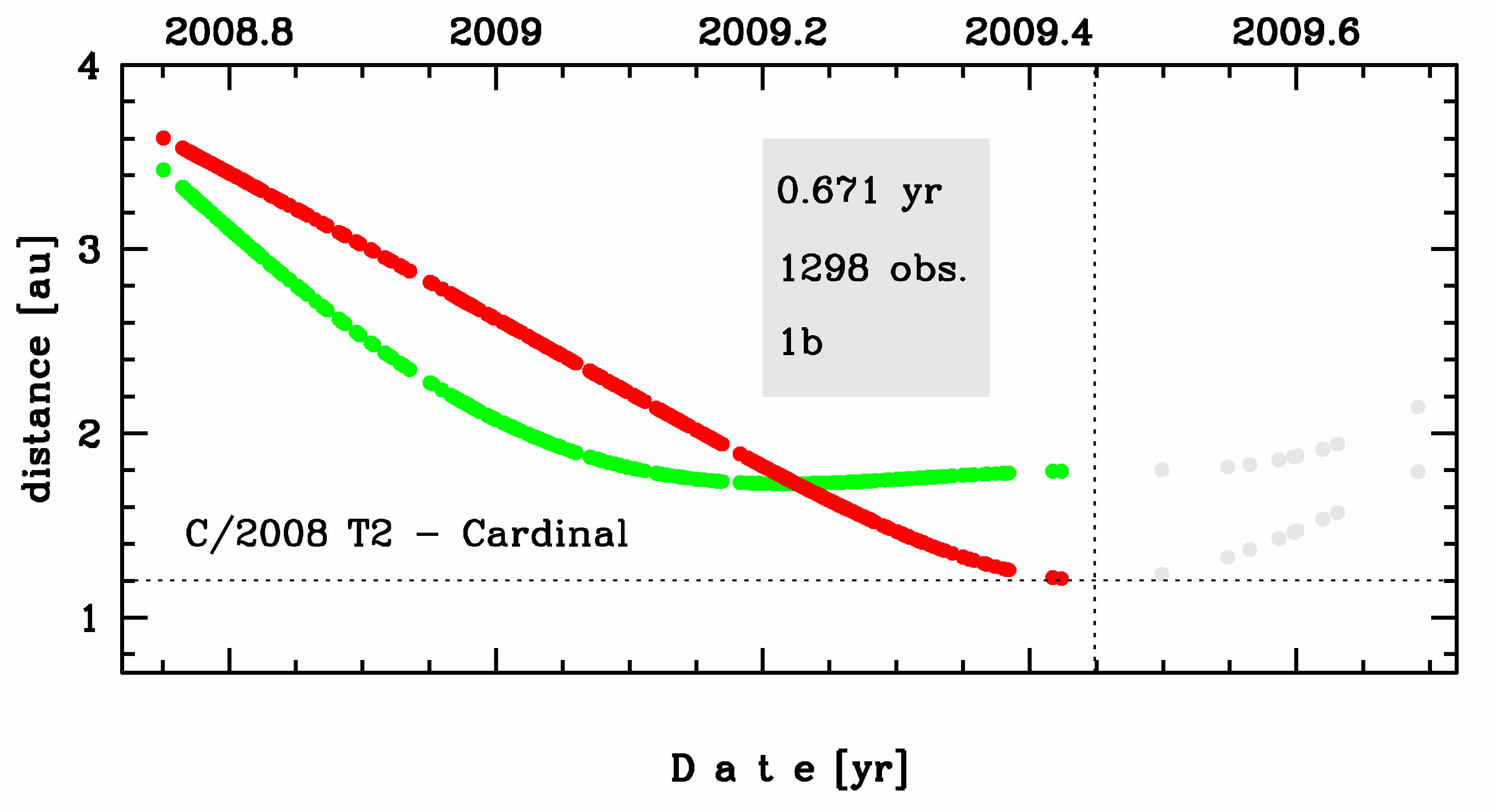C/2008 T2 Cardinal
more info
Comet C/2008 T2 was discovered on 1 October 2008 by Rob D. Cardinal (University of Calgary, Priddis); that is about 8.5 months before its perihelion passage. The comet was observed until 9 September 2009.
Comet had its closest approach to the Earth on 20 March 2009 (1.727 au), about 3 months before its perihelion passage.
Preferred solution given here is based on entire data set spanning over 0.939 yr in a range of heliocentric distances: 3.60 au – 1.202 au (perihelion) – 1.78 au; however, the radial component of this non-gravitational solution is negative.
This Oort spike comet suffers small planetary perturbations during its passage through the planetary system; these perturbations lead to more tight future orbit (see future barycentric orbits).
See also Królikowska and Dybczyński 2013 and Królikowska 2020.
Comet had its closest approach to the Earth on 20 March 2009 (1.727 au), about 3 months before its perihelion passage.
Preferred solution given here is based on entire data set spanning over 0.939 yr in a range of heliocentric distances: 3.60 au – 1.202 au (perihelion) – 1.78 au; however, the radial component of this non-gravitational solution is negative.
This Oort spike comet suffers small planetary perturbations during its passage through the planetary system; these perturbations lead to more tight future orbit (see future barycentric orbits).
See also Królikowska and Dybczyński 2013 and Królikowska 2020.
| solution description | ||
|---|---|---|
| number of observations | 1298 | |
| data interval | 2008 10 01 – 2009 06 03 | |
| data arc selection | data generally limited to pre-perihelion (PRE) | |
| range of heliocentric distances | 3.6 au – 1.6au | |
| detectability of NG effects in the comet's motion | comet with determinable NG~orbit | |
| type of model of motion | GR - gravitational orbit | |
| data weighting | YES | |
| number of residuals | 2609 | |
| RMS [arcseconds] | 0.38 | |
| orbit quality class | 1b | |
| previous orbit statistics, both Galactic and stellar perturbations were taken into account | ||
|---|---|---|
| no. of returning VCs in the swarm | 0 | |
| no. of escaping VCs in the swarm | 5001 | * |
| no. of hyperbolas among escaping VCs in the swarm | 0 | |
| previous reciprocal semi-major axis [10-6 au-1] | 11.14 – 12.47 – 13.80 | |
| previous perihelion distance [au] | 3360 – 3490 – 3620 | |
| previous aphelion distance [103 au] | 142 – 157 – 176 | |
| time interval to previous perihelion [Myr] | 3.81 ± 11 | |
| percentage of VCs with qprev > 20 | 100 | |
| previous orbit statistics, here only the Galactic tide has been included | ||
|---|---|---|
| no. of returning VCs in the swarm | 0 | |
| no. of escaping VCs in the swarm | 5001 | * |
| no. of hyperbolas among escaping VCs in the swarm | 0 | |
| previous reciprocal semi-major axis [10-6 au-1] | 10.56 – 11.96 – 13.34 | |
| previous perihelion distance [au] | 27.1 – 29.3 – 31.6 | |
| previous aphelion distance [103 au] | 150 – 170 – 190 | |
| time interval to previous perihelion [Myr] | 3.79 ± 11 | |
| percentage of VCs with qprev > 20 | 100 | |
